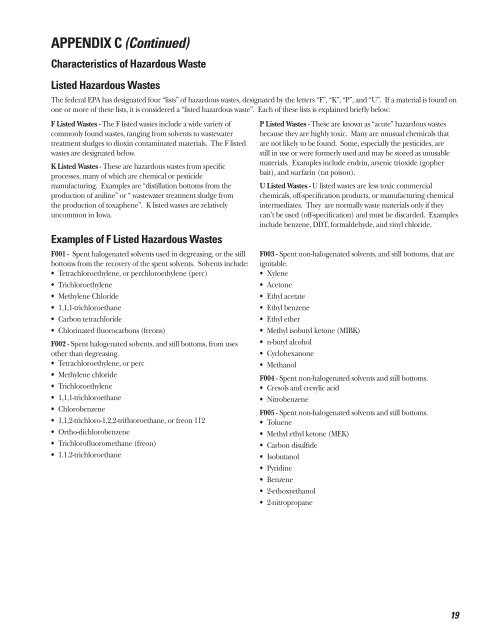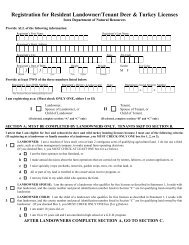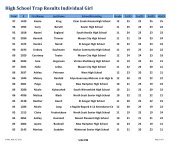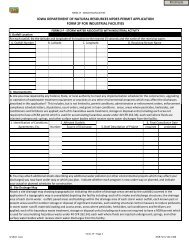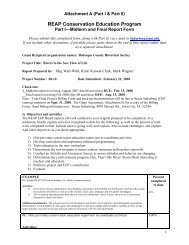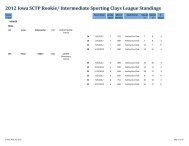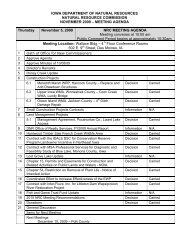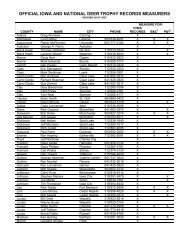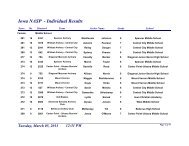Waste Reduction, Construction and Demolition Debris - Iowa ...
Waste Reduction, Construction and Demolition Debris - Iowa ...
Waste Reduction, Construction and Demolition Debris - Iowa ...
You also want an ePaper? Increase the reach of your titles
YUMPU automatically turns print PDFs into web optimized ePapers that Google loves.
APPENDIX C (Continued)<br />
Characteristics of Hazardous <strong>Waste</strong><br />
Listed Hazardous <strong>Waste</strong>s<br />
The federal EPA has designated four “lists” of hazardous wastes, designated by the letters “F”, “K”, “P”, <strong>and</strong> “U”. If a material is found on<br />
one or more of these lists, it is considered a “listed hazardous waste”. Each of these lists is explained briefly below:<br />
F Listed <strong>Waste</strong>s - The F listed wastes include a wide variety of<br />
commonly found wastes, ranging from solvents to wastewater<br />
treatment sludges to dioxin contaminated materials. The F listed<br />
wastes are designated below.<br />
K Listed <strong>Waste</strong>s - These are hazardous wastes from specific<br />
processes, many of which are chemical or pesticide<br />
manufacturing. Examples are “distillation bottoms from the<br />
production of aniline” or “ wastewater treatment sludge from<br />
the production of toxaphene”. K listed wastes are relatively<br />
uncommon in <strong>Iowa</strong>.<br />
Examples of F Listed Hazardous <strong>Waste</strong>s<br />
F001 - Spent halogenated solvents used in degreasing, or the still<br />
bottoms from the recovery of the spent solvents. Solvents include:<br />
• Tetrachloroethylene, or perchloroethylene (perc)<br />
• Trichloroethylene<br />
• Methylene Chloride<br />
• 1,1,1-trichloroethane<br />
• Carbon tetrachloride<br />
• Chlorinated fluorocarbons (freons)<br />
F002 - Spent halogenated solvents, <strong>and</strong> still bottoms, from uses<br />
other than degreasing.<br />
• Tetrachloroethylene, or perc<br />
• Methylene chloride<br />
• Trichloroethylene<br />
• 1,1,1-trichloroethane<br />
• Chlorobenzene<br />
• 1,1,2-trichloro-1,2,2-trifluoroethane, or freon 112<br />
• Ortho-dichlorobenzene<br />
• Trichlorofluoromethane (freon)<br />
• 1.1.2-trichloroethane<br />
P Listed <strong>Waste</strong>s - These are known as “acute” hazardous wastes<br />
because they are highly toxic. Many are unusual chemicals that<br />
are not likely to be found. Some, especially the pesticides, are<br />
still in use or were formerly used <strong>and</strong> may be stored as unusable<br />
materials. Examples include endrin, arsenic trioxide (gopher<br />
bait), <strong>and</strong> warfarin (rat poison).<br />
U Listed <strong>Waste</strong>s - U listed wastes are less toxic commercial<br />
chemicals, off-specification products, or manufacturing chemical<br />
intermediates. They are normally waste materials only if they<br />
can’t be used (off-specification) <strong>and</strong> must be discarded. Examples<br />
include benzene, DDT, formaldehyde, <strong>and</strong> vinyl chloride.<br />
Examples of F Listed Hazardous <strong>Waste</strong>s<br />
F003 - Spent non-halogenated solvents, <strong>and</strong> still bottoms, that are<br />
ignitable.<br />
• Xylene<br />
• Acetone<br />
• Ethyl acetate<br />
• Ethyl benzene<br />
• Ethyl ether<br />
• Methyl isobutyl ketone (MIBK)<br />
• n-butyl alcohol<br />
• Cyclohexanone<br />
• Methanol<br />
F004 - Spent non-halogenated solvents <strong>and</strong> still bottoms.<br />
• Cresols <strong>and</strong> cresylic acid<br />
• Nitrobenzene<br />
F005 - Spent non-halogenated solvents <strong>and</strong> still bottoms.<br />
• Toluene<br />
• Methyl ethyl ketone (MEK)<br />
• Carbon disulfide<br />
• Isobutanol<br />
• Pyridine<br />
• Benzene<br />
• 2-ethoxyethanol<br />
• 2-nitropropane<br />
19


